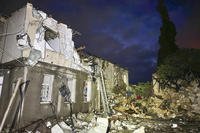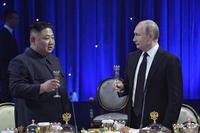Arms control elicits strong emotions and sparks great debates. In that tradition, Kingston Reif and Travis Sharp offer a rebuttal to the recent commentary we ran from the folks at the Heritage Foundation. Here's the take of two dedicated arms control advocates:
In their recent commentary on DoD Buzz (“Will START Talks Go MAD,”), the Heritage Foundation’s Baker Spring and Helle Dale recycle a snake oil sales pitch that first emerged at the dawn of the Atomic Age. The illusion is that the awesome destructiveness of nuclear weapons can somehow be neutralized by a panacea—in this case impenetrable missile defenses. Such reveries call to mind journalist Fred Kaplan’s conclusion in "Wizards of Armageddon" about analysts flogging magical cure-alls: “The nuclear strategists had come to impose order -– but in the end, chaos still prevailed.”
It may offend Spring’s and Hale’s moral sensibilities, but the fact remains that the United States is, and will continue to be, vulnerable to nuclear attack so long as nuclear weapons exist. Dumping tried and true deterrence and arms control strategies that manage and minimize nuclear dangers in favor of an uncertain missile defense-centric approach, as Spring and Hale recommend, would needlessly endanger U.S. security.
It is technologically possible for missile defenses to protect against limited nuclear threats posed by regional aggressors such as North Korea. Yet the technology required to intercept a large number of long-range missiles equipped with decoys and countermeasures does not exist and may never exist. Even the most futuristic missile defenses will likely be overwhelmed by a well-equipped adversary that is willing simply to build more offensive missile forces. Political and military leaders will never be completely sure that missile defenses will intercept all of an enemy's incoming missiles.
None of which means that the United States and Russia shouldn’t jointly pursue efforts to develop more capable missile defenses. To their credit, Spring and Hale recognize that their missile defense-centric scheme can only be pursued if the United States and Russia both develop defenses, although they don’t stipulate that any realistic effort would have to be joint in order to avoid mutual suspicions and arms racing. Spring and Hale also neglect to justify why they believe continuing development of missile defenses must come at the expense of a follow-on agreement to START I, which will not reduce nuclear forces to a level where missile defenses might plausibly threaten retaliatory capability. The two efforts are not mutually exclusive and framing them as such presents a false dilemma.
A START follow-on agreement offers attractive security benefits for the United States. Its new limits and streamlined verification provisions will ensure a stable and predictable U.S.-Russian nuclear relationship. Russia’s nuclear weapons cannot be wished away, and the threat they pose must be dealt with realistically by the United States. New limits and verification provisions will give each side important information about the size and location of the other’s nuclear forces while reducing the chances for misunderstandings that could lead to an accidental or unauthorized nuclear exchange. Moreover, the United States will still be able to maintain a robust nuclear deterrent.
The best way to address the threat of nuclear terrorism is by securing vulnerable nuclear materials and verifiably reducing nuclear stockpiles. U.S. and Russian nuclear reductions – combined with other measures to eliminate Russian delivery systems and vulnerable weapons-grade nuclear material – will reduce the risk that weapons or materials could be stolen and used in a nuclear terrorist attack.
For these reasons, and many more, a START follow-on is supported by a wide swath of conservative and liberal policy experts. In 2009, the bipartisan U.S. Strategic Posture Commission judged that “The United States and Russia should pursue a step-by-step approach and take a modest first step to ensure that there is a successor to START I.” These experts understand that the alternative to a START follow-on is clear: no means of limiting or monitoring Russia’s still enormous nuclear arsenal. Such an outcome would make the United States less safe.
Contrary to what Spring and Hale contend, the Obama administration is currently working to reap the numerous security benefits of a START follow-on without allowing negotiated limits to be placed on U.S. missile defenses. For example, the recently released Ballistic Missile Defense Review noted that “the [Obama] Administration will continue to reject any negotiated restraints on U.S. ballistic missile defenses.” American negotiators could have caved to their Russian counterparts on missile defenses or any of the other complex issues that have delayed signature well past START I’s expiration on December 5. But they didn’t.
Despite posturing by Russian Prime Minister Vladimir Putin, the two sides are likely to produce an agreement that notes the interrelationship between offensive and defensive forces – which is an objective reality – but does not contain any formal or legal limitations on missile defenses. The Obama administration has gone to extraordinary lengths to preserve U.S. freedom of action vis-à-vis missile defenses.
The Russian interest in concluding a follow-on agreement to START will likely outweigh their concerns about U.S. missile defenses for the time being. However, the United States is unlikely to be able to convince the Russians to forego these concerns if future negotiations take place on even deeper cuts in U.S. and Russian arsenals.
Thus, in the absence of joint missile defenses that assuage mutual concerns, U.S. leaders may soon face a stark choice: reduce nuclear stockpiles below START follow-on levels, or continue to insist on zero restrictions on U.S. missile defenses.
Kingston Reif is the Deputy Director of Nuclear Non-Proliferation at the Center for Arms Control and Non-Proliferation. Travis Sharp is a Research Associate at the Center for a New American Security. They blog about nuclear weapons policy at Nukes of Hazard.








